
|   |

|   |
 e-mail: sunilkothari1933@gmail.com Remembering Ebrahim Alkazi August 13, 2020 It was during the year 1954 that my late dear painter friend Bhupen Khakhar and I were attending a series of lectures by Ebrahim Alkazi at Bhulabhai Memorial Institute on Warden Road (later on it was renamed as Bhulabhai Desai Road). It was a cultural hub, a meeting place for painters, musicians, photographers, theatre directors, actors, and dancers. Soli Batliwala was the trustee of the Institute along with Madhuri Desai, daughter-in-law of Bhulabhai Desai. Alkazi saab was speaking on the Blue and Rose period of world renowned painter Picasso. In front row was seated Vanaraj Bhatia, the celebrated musician whose knowledge of Western classical music was the talk of the town. Many years later he composed music for our painter, poet friend Gulam Mohammad Sheikh on his poems on Jaisalmer. It was fascinating to see the colour slides which Alkazi saab was screening for his lectures. His love for painting made the lectures most enlightening. He had studied painting and also drew sketches in ink and also few oil paintings. 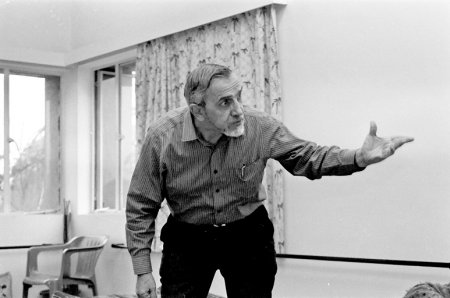
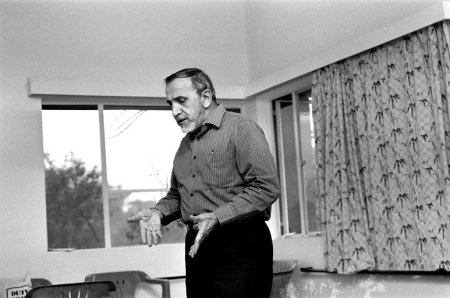
Courtesy: Shobha Deepak Singh But since he had studied dramatics at Royal College of Dramatic Arts in London, he chose theatre to painting. He established Theatre Unit, published a journal also. He staged plays on the terrace of his residence at Napeansea Road, where we had seen his direction of Samuel Becket's play 'Waiting for Godot.' Not that at that time Bhupen and I could follow or appreciate it, but because of its thorough professional approach it left an indelible impression. The late 50s and early 60s were a very exciting period. I remember also Ibsen's play 'Hedda Gabbler' in which Hima Devi, the well known dancer had played the lead role. Alkazi saab joined hands with the Padamsees who were very active in presenting English Theatre. We had also seen one of Alkazi saab's play at Bhulabhai Memorial Institute staged in open air stage. 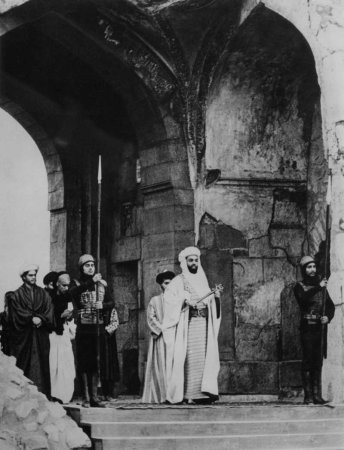 'Tughlaq' by Girish Karnad, Dir. E. Alkazi, National School of Drama, Purana Qila, New Delhi 1976 Courtesy: Alkazi Theatre Archives 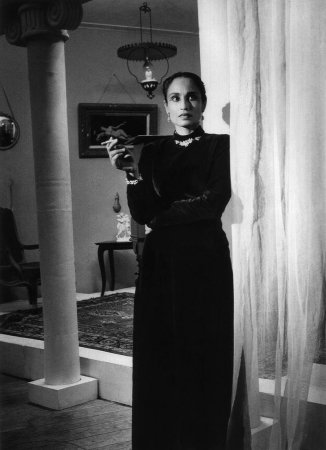 'Hedda Gabler' by Henrik Ibsen. Dir. E. Alkazi. Hima Devi as Hedda Gabler. Theatre Unit, Bombay, 1958. Courtesy: Alkazi Theatre Archives Alkazi saab moved to New Delhi to head the National School of Drama in 1962 and was director there till 1977. He revolutionized the Hindi theatre. His staging of Shakespeare's plays took the public by surprise for thorough professionalism. As a director of the national institute he brought an order, a curriculum for theatre studies, direction, music, acting, set design, study of western plays, established a rich library. He believed in having the place for study, theatre, performance, spic and span. It has become folklore in Indian theatre that Alkazi saab took broom and cleaned the toilets! He was a strict disciplinarian, believed in keeping time, students dare not come late for the classes, or display any slackness in competing the homework assigned to them. He spoke chaste English and mastered Hindi. Born in Pune in a well-to-do Arab family, he knew Marathi well, had studied at St. Xavier's College in Mumbai and later on had been to London. 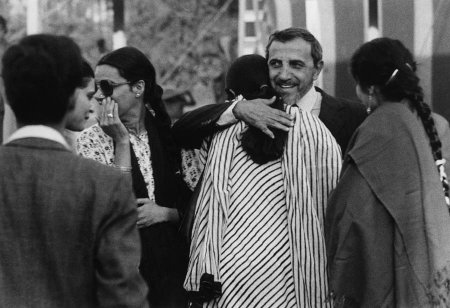 E. Alkazi with his students in Bombay on the occasion of the Time Talents Award, 1998 Courtesy: Alkazi Theatre Archives 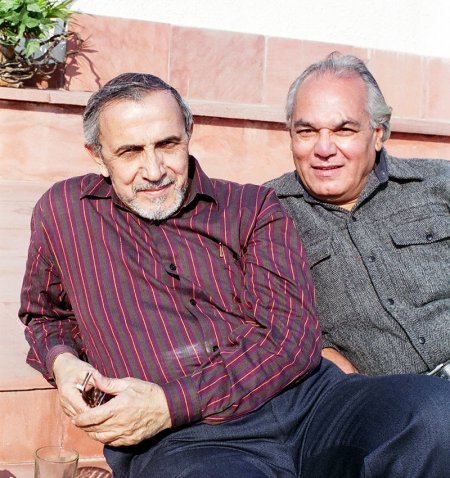 E. Alkazi with Manoher Singh Courtesy: Alkazi Theatre Archives 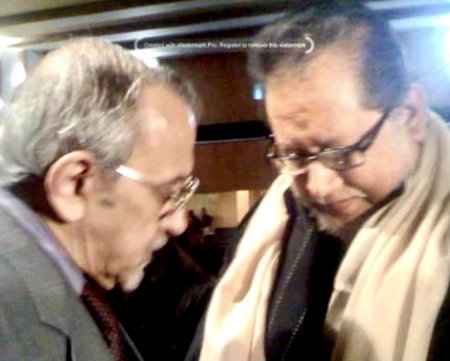 E. Alkazi with Ratan Thiyam Courtesy: Shobha Deepak Singh Besides Western theatre he staged with equal respect Hindi plays, Girish Karnad's Tughlaq, Premchand's Godan, Jasma Odan directed by Shanta Gandhi. His by now legendary staging of Dharamveer Bharati's 'Andha Yug' at Firozshah Kotla ground and later on at Purana Quila is too well known, and were attended by Prime Minister Pandit Jawaharlal Nehru and also by Atal Bihari Vajpeyi. Among his colleagues was Govardhan Panchal whose seminal work on Koodiyattam resulted in a book published by Sangeet Natak Akademi. He had invited Shivram Karanth to direct a play in Yakshagana style, Barman Van. 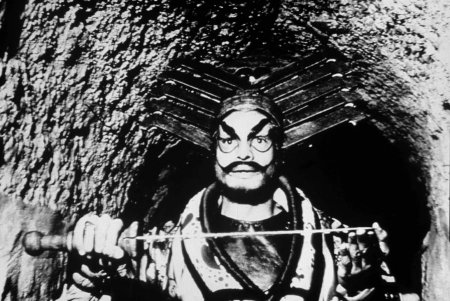 'Andha Yug' by Dharamveer Bharati, Dir. E. Alkazi. Rajesh Vivek as Ashwatthama, National School of Drama, Purana Qila, New Delhi, 1974 Courtesy: Alkazi Theatre Archives 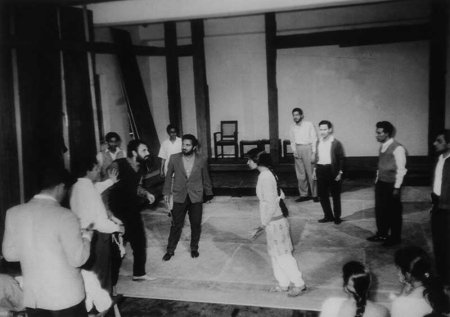 E. Alkazi at the rehearsal of 'King Lear,' National School of Drama, New Delhi, 1964 Courtesy: Alkazi Theatre Archives Exposing the student to world theatre, Japanese Noh plays were staged. The theories included study of Bharata's Natyashastra and aesthetics of Zeami. Students were encouraged to visit paintings at National Gallery of Modern Arts. They were asked to attend classical dance performances by legendary dancers like Balasaraswati, Kathakali by great Kathakali actors, and Kathak by the Kathak maestros and Manipuri by visiting dance troupes. Training in dance, which was termed study of movements, was a must. He invited Rita Ganguly to teach movement to actors. A versatile Kathakali and Bharatanatyam dancer having studied under great masters, Rita had also studied Kathak and Modern dance under Martha Graham. She had learnt Hindustani vocal music under Siddheswari Devi and Begum Akhtar. The martial arts were also part of training - not only Kerala's Kalaripayattu but also Manipur's Thang-ta with swords and spear. The entre approach was holistic. To get admission to NSD was considered a great boon. Earlier the National School of Drama was a part of Sangeet Natak Akademi and classes were held on the third floor of Rabindra Bhavan, where a small theatre was specially built to rehearse and stage plays. Later on, NSD moved to Bhagwandas Road and had more spacious place for classes and staging plays. Alkazi saab created an open air theatre behind Rabindra Bhavan titled Meghdoot where in open air, plays were staged. I have many happy memories of having seen plays there, among which I recall having seen 'Begum Barve' in which Uttara Baokar had played the lead role and sung the songs. Later on, I had seen 'Mahabhoj' play directed by Amal. Whenever I visited Delhi, I never missed any opportunity to see the plays at NSD. It was a great education to watch the plays and meet actors some of whom became friends; among them Ratan Thiyam is my dearest friend and later on I worked with him for more than thirty years, visiting Imphal, watching the rehearsals and seeing the plays. I travelled with his Chorus Repertory Theatre world over and could see how under guidance of Alkazi saab, Ratan had imbibed the art. My close association with Ratan brought me close to Alkazi saab. I was a great admirer of Alkazi saab. He used to attend my lec-dems on dance. One was arranged at Pergola of India International Centre and Uma Sharma was performing. He liked our lec-dem and encouraged me to continue such series. Jiwan Pani, the Odiya poet and scholar, had joined SNA as Asst Director for documentation. He had produced 'Ravan Chhaya,' a documentary film on shadow plays of puppets of Odisha. When he approached Alkazi saab to give commentary in English, he readily agreed. Meeting him was always an education. He was particular about timings and would make a note in his small pocket diary if he gave an appointment to meet. I was very impressed by that and learnt it from him to not only make a note but also to maintain time. Many years ago, he had come to see the first exhibition of my painter and poet friend Gulam Mohammad Sheikh at Jahangir Art Gallery which was inaugurated by M.F. Hussain and Hussain saab had read a poem also. Alkazi saab had liked Gulam's paintings and invited him for dinner. Alkazi saab being a connoisseur of painting, appreciated Gulam's work and invited him to give lecture at NSD where Gulam recently reminisced that their interest and knowledge of world masters was common, their lectures were like a jugalbandhi! For appreciation of textiles, he had invited Nibha Joshi to give lectures on aesthetics. He was open to so many things artistic. He admired my books on dance published by Dr. Mulk Raj Anand for Marg Publications. When Ashok Vajpeyi started dance festival at Khajuraho, we all acknoweldged the debt we owe to Alkazi saab, as he has set an example by staging plays at historical monuments. He was invited to be a member of a committee to decide how the dances were to be staged at Khajuraho. I was one of the members of the committee. Along with Alkazi saab, the renowned architect Mr. Stein who designed India International Centre and Triveni Kala Sangam was also with us. In the committee, there was also one government officer. He was not enthusiastic about dances being performed on the parapet of the Kandariya Mahadev Temple complex. Alkazi saab in his characteristic manner spoke that the honourable member perhaps would prefer to have dances on railway platforms of Satan. And that was that. The officer learnt his lesson. The festival of dance at Khajuraho took off well. Akazi saab also gave valuable suggestions for lighting. His vision was vast and knew how to integrate dance and temple sculpture! 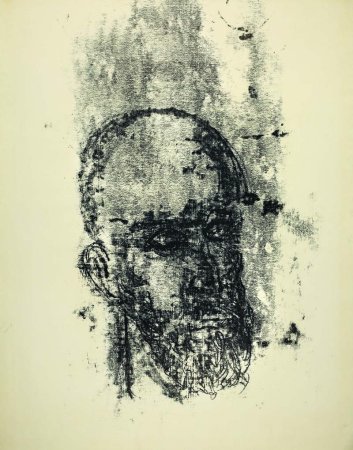 Artist E. Alkazi. Head 1, c. 1960s, Mixed media on paper, 23 x 17.75 ins. Courtesy: The Alkazi Collection of Art After retirement Alkazi saab devoted his time to painting and established at Triveni Kala Sangam, Art Heritage and a gallery. His wife Roshen Alkazi organized many exhibitions. She also wrote two books on the costumes of India. Very few know that Roshen Alkazi went to Chennai for three months to study abhinaya from Balasaraswati. Because of my interest in dance, Roshen and I had become close friends. One more connection with family of Alkazi saab was my acquaintance with Nissar Allana, the set designer, who married Amal. I knew Nissar in Mumbai and we used to invite him for lectures on set design at Bharatiya Vidya Bhavan. Both Amal and Nisaar have established an institution for preservation of sets and also photographs. Their son Rahab is an excellent photographer and is looking after an archive of photography. Their daughter Zulekha is a brilliant lights designer. When Chandralekha choreographed a duet Navagraha with Kamadev, which was a departure from traditional margam Bharatanatyam, and was staged at Kamani Hall, Alkazi saab had specially attended it and welcomed Chandralekha as a modern dancer praising her work and concepts. During Alkazi saab's tenure, from Israel one dancer by name Deborah had visited New Delhi. I was staying with Mohan Khokar who was at that time Asst Director for Dance at SNA. After interviewing Deborah, I asked her if she would give a performance for dancers and local theatre students. She agreed but we did not have a place to present her. I approached Alkazi saab if he would allow us to present her at the small theater on third floor of SNA where he used to take rehearsals. Not only he readily agreed but also attended the performance. I was so happy that Alkazi saab assisted us. 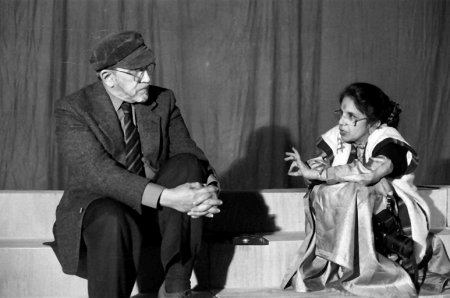 E. Alkazi with Shobha Deepak Singh 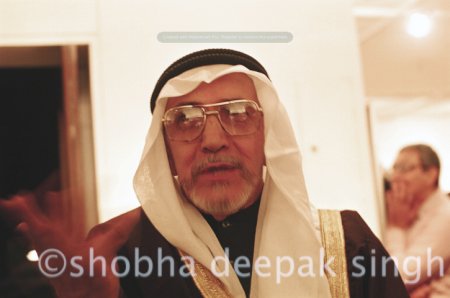 E. Alkazi Alkazi saab guided and taught Shobha Deepak Singh in photography. Seeing her special gift in taking photographs, Alkazi saab helped her a lot. Shobha has turned into a brilliant photographer and she acknowledges her debt to Alkazi saab. She says if she is a photographer, it is all because of Alkazi saab. When we were in New York in 2000 for our tour of Chorus Repertory Theatre and presenting 'Uttar Priyadarshi' at Brooklyn Academy of Music (BAM) theatre, Alkazi saab was in New York. I was asked to receive him and take him to his seat. I waited anxiously but on account of traffic Alkazi saab was late on reaching BAM and the play had begun. As per the rules, till the first scene was over, we cannot enter the theatre. Alkazi saab apologized for being late. However, we got settled for the play. I sent a word to Ratan who was doing lighting of the play that after the show was over Alkazi Saab would come to meet him and artistes back stage. We went after the show concluded to back stage. The moment Ratan saw Alkazi saab, he fell on the floor and did what we call shastanga danadvata pranam. Alkazi saab embraced him and blessed him. He was feeling so proud of his disciple! Their meeting back stage brought tears of joy to many of us. After Ratan's play at Bharat Rang Mahotsav was over and the curtain call, Alkazi saab was invited to come to the stage to felicitate Ratan. That was another emotional scene when he touched Alkazi saab's feet and he embraced him. It was a special occasion and the highest prize in name of Alkazi saab was presented to Ratan by Alkazi himself. Once again there were many of us whose eyes were full of tears. Alkazi saab in later years had after retiring, directed a few plays but most of the time he was busy with collecting paintings for Art Heritage and also photographs. Whenever we met him, he was very cordial. He would ask me about Chorus Repertory Theatre's tours abroad, and would express happiness for Ratan's success. With advancing age he was not keeping well. He had loss of memory and was suffering from Alzheimer's disease. He was advised to take rest and Amal and others took great care of him. He passed away on 4th August 2020.  Dr. Sunil Kothari is a dance historian, scholar, author and critic, Padma Shri awardee and fellow, Sangeet Natak Akademi. Dance Critics' Association, New York, has honoured him with Lifetime Achievement award. Post your comments Please provide your name and email id when you use the Anonymous profile in the blog to post a comment. All appropriate comments posted with name and email id in the blog will also be featured in the site. |